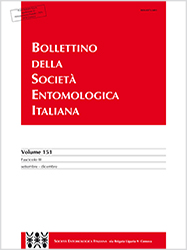Articoli
V. 146 N. 1 (2014)
Field selectivity of a spinosad-poisoned bait toward target tephritids and non-target insects

Publisher's note
All claims expressed in this article are solely those of the authors and do not necessarily represent those of their affiliated organizations, or those of the publisher, the editors and the reviewers. Any product that may be evaluated in this article or claim that may be made by its manufacturer is not guaranteed or endorsed by the publisher.
All claims expressed in this article are solely those of the authors and do not necessarily represent those of their affiliated organizations, or those of the publisher, the editors and the reviewers. Any product that may be evaluated in this article or claim that may be made by its manufacturer is not guaranteed or endorsed by the publisher.
Received: 15 aprile 2014
Accepted: 15 aprile 2014
Accepted: 15 aprile 2014
548
Visite
567
Downloads






